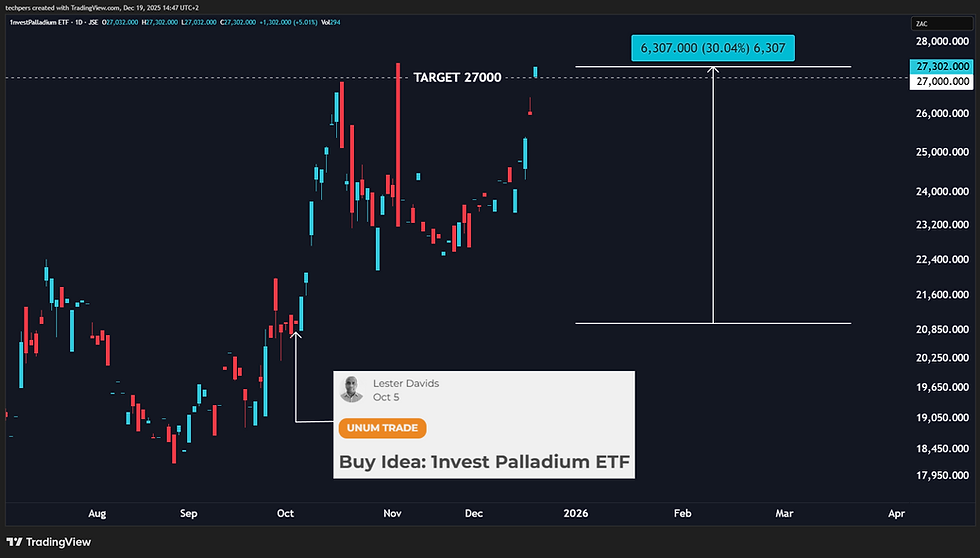Invest in Autonomous Tech & Robotics
- Lester Davids

- Jun 23
- 3 min read
Research Notes For 23 to 27 June > https://www.unum.capital/post/r2327june
Trade Local & Global Financial Markets with Unum Capital.
To get started, email tradingdesk@unum.co.za
ARK Autonomous Tech & Robotics ETF (ARKQ)
Coiling for a Major Move
After a multi-year consolidation period, the ARK Autonomous Technology & Robotics ETF (ARKQ) is now pressing up against a major resistance level around $90.26. This prolonged basing pattern is technically significant; it often represents a slow transfer of shares from weaker, short-term holders to stronger, long-term investors who are accumulating a position. Such patterns can store a tremendous amount of kinetic energy.
A decisive breakout above the ~$90 resistance level would not just be a technical event; it would signal a fundamental shift in market perception, potentially releasing that pent-up energy and initiating a new, sustained uptrend. The current status is "Breakout Pending," as the ETF consolidates just below this critical level. The primary strategy is to wait for confirmation of the breakout before initiating new long positions, as false breakouts are a risk.

2. Visualizing the Breakout Setup
The price chart of ARKQ shows a long consolidation period where the price has been building a "cause" (the base) for a new advance. The key levels to watch are:
Key Resistance (~$90.26): This level represents the ceiling of the multi-year consolidation range. A decisive weekly or monthly close above this price is the required trigger for a bullish breakout.
Support Zone (~$71.18): This level represents the floor of the recent basing pattern. A break below this support would invalidate the bullish thesis and suggest a continuation of the consolidation or a potential bearish reversal.
3. Top Holdings & Thematic Drivers
The ETF's performance is driven by its holdings in companies at the forefront of disruptive innovation. Key holdings and their themes include:
Tesla (TSLA): A leader in electric vehicles, battery technology, and, crucially for this ETF, the development of full self-driving (FSD) capabilities and the Optimus humanoid robot.
Trimble Inc. (TRMB): Provides high-precision positioning technology (GPS) for agriculture, construction, and transportation, enabling the automation and increased efficiency of core industrial sectors.
Kratos Defense (KTOS): A key player in the development of unmanned aerial systems (drones) and other autonomous technologies for modern defense and security applications.
4. Fundamental Themes Driving the Sector
4.1. Bullish Catalysts (Tailwinds):
AI & Automation Adoption: The explosion in AI and machine learning is creating unprecedented demand for robotics and industrial automation to improve efficiency, lower costs, and enhance capabilities across all industries.
Secular Growth Trends: The ETF provides focused exposure to long-term, high-growth themes such as autonomous vehicles, 3D printing, space exploration, and advanced manufacturing, which are still in their early innings.
Reshoring & Supply Chain Modernization: A global trend towards reshoring manufacturing requires massive investment in new, highly automated factories, which is a direct tailwind for the robotics industry.
4.2. Bearish Catalysts (Headwinds):
High Valuation & Rate Sensitivity: Many holdings are high-growth, long-duration assets with premium valuations. This makes them particularly sensitive to changes in interest rates; higher rates can significantly compress their valuation multiples.
Economic Cyclicality: Corporate spending on large-scale automation and robotics projects is often cyclical. In a significant economic downturn, companies may delay or cancel these capital-intensive projects, impacting the sector's growth.
Regulatory & Ethical Hurdles: The rapid advancement of AI and autonomous systems faces growing ethical questions and the increasing likelihood of government regulation, which could slow down deployment and create compliance costs.
5. Price Action Probabilities
Bullish Breakout (65% Probability): The primary scenario. The ETF musters enough buying pressure to close decisively above the ~$90.26 resistance, signaling the start of a new major uptrend with significant upside potential.
Continued Consolidation (25% Probability): The price fails to break out on its initial attempt and continues to consolidate sideways below resistance, building more cause for a future, potentially more powerful, move.
Failed Breakout & Reversal (10% Probability): The alternative scenario. The breakout attempt fails decisively, and the price reverses lower, breaking below the prior support zone around $71.18, which would be a major bearish signal.
6. The Tactical Playbook
A simplified, three-step decision model for trading the potential breakout:
WATCH: Monitor the price action at the key resistance level of ~$90.26. It is advisable to avoid entering a trade while the ETF is below this level.
CONFIRM: A true breakout requires a decisive close (preferably on a weekly basis) above resistance, ideally accompanied by an increase in trading volume to confirm buyer conviction.
MANAGE RISK: After a successful breakout, the old resistance level (~$90.26) becomes the new technical support. A stop-loss could be placed below this level to manage risk on a long position.
Lester Davids
Senior Investment Analyst: Unum Capital




Comments